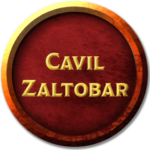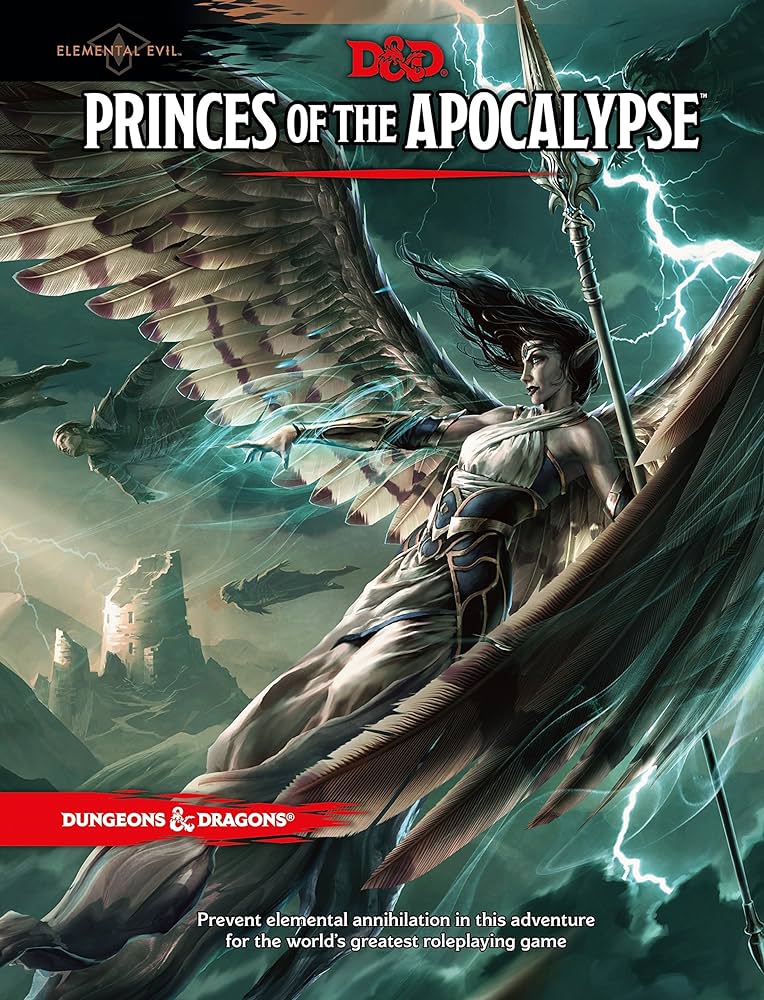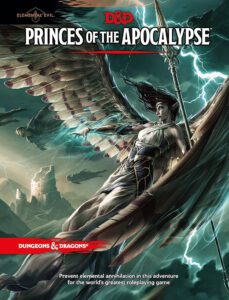This is part of a series about my DMing Princes of the Apocalypse, a D&D 5e adventure by and copyright Wizards of the Coast.
There will be SPOILERS. If you are playing in a PotA game, please don’t read this. If you are DMing a PotA game, or are a DM who wants to see what the ride was like … read on!
Our group’s previous game was winding up — the whole big Tyranny of Dragons two-fer, GMed by a friend of ours — and I was hankering to do some DMing myself.
This is that story.
So who am I?
I’ve been playing FRPGs (as Fantasy TTRPGs used to be called, back before being Table-Top was a minority position) for over four decades — but rarely actual D&D.
- In college my gaming group did a lot of homebrew FRPGs. Mine was loosely based on mechanics from Runequest. While other students were spending their Saturday nights getting blitzed, I was reworking my spell books and setting up errata for the following Friday’s game. Or hand-drawing elaborate invitations for same. I had no life, but it was good. (It was especially good because it was in a friend’s game that I met my future wife, so huzzah for gaming!)
- Post-college, I got heavily into GURPS (oh, the crunchiness!), a variety of Super-Hero RPG rules, and Amber Diceless Roleplaying (oh, the non-crunchiness!).
- In the early 00s through 10s, the gaming group I was in got pulled into the D&D 3.5 orbit, and we did a lot of different games and settings. I myself DMed a number of campaigns, including some fun spy-based stuff (run both under FATE and using the D20 Spycraft rules). We also did a lot of indie RPGs — Sorcerer, Nobilis, and the like.
- The 20s brought the Virtual Tabletop — an answer to “How do we, as adults with kids, drive to a game after work, play a game, drink beer during the game, then drive home safely after the game?” We were eventually doing Roll20 stuff well before COVID, and loving it. Sure, it meant much less of an excuse to binge on Nacho Cheese Doritos, but it meant a lot more opportunity to game, and with people outside the geographical area. We did a lot of gaming in that context, but some of my favorite used Powered by the Apocalypse (PbtA) rulesets, esp. Masks.
- And then a friend of ours offered to DM a game for his wife, and me, and my wife (the same one as see first bullet above) — the whole Tyranny of Dragons D&D 5e campaign. And this led to much buying of 5e books. And we would do it over Roll20 (even though we lived just 5 minutes away from each other) because (a) parenting and then (b) COVID. And it all worked beautifully.
Which, again, once it came to a close, was my cue to step up and be the DM for the first time in a decade-plus. No small trepidations there, but, rather than rolling my own scenarios, I’d be using modules, which … for better or worse … I thought I could deal with. But what would I DM …?
The Campaign’s the Thing
My criteria for what we were going to play?
- I wanted an official WotC campaign. That seemed the safest bet. It was limiting, but I figured it had the biggest resource base (producer and players) and so would be the best errata’d and “fixed” through both the company and the community.
- I wanted something that would run characters up through most of their potential levels. In other words, a long game. Going from 1-5 would then mean looking for something more. If I could find a game, like the Tyranny of Dragons, that would take the characters up toward the max, I’d be quite happy.
- I wanted something supported by Roll20, our VTT of choice (or at least what we were used to, and that’s a debate for another forum). I mean, I was sure I could scan something in and build maps and things like that, but I didn’t want to bite off more than I could chew. (Ha!)
So I read through reviews, weighing things that looked cool vs. things that looked daunting. And finally decided on Princes of the Apocalypse — a wide-ranging, level 1-15ish (13, actually, but some of the lit says 15) romp across open terrain and underground and fighting against the end of the world as we know it.
And, overall, it was a good choice. It’s a complex project, lots of moving parts, and very sandboxy (or, rather, non-railroady). In ToD, it all felt like “Okay, you have done X, now on to do Y.” In PotA, it’s much more, “Okay, you have done X … what are you doing now. Oh, yeah, there’s Y, Z, Q, and any other direction one might want to go.”
Let me do a quick eval of PotA and some of its strengths and weaknesses.
PotA Writing and Age and Support
PotA came out in 2015, one of the earliest 5e campaigns (though post-ToD), which means lots of folk have played it and DMed it. While this could mean spoilers, etc., it also means that there’s a lot of advice for things to do/not do, supplemental home-brewed materials, and so forth. I drew on that a lot, and will highlight materials I used further down the line.
It is, though, an “older” game, meaning that a lot of the lessons that WotC (and others) have learned in module construction in 5e since the system went live aren’t here. There are places where it plays more straightforwardly than it might, and places were it’s not quite as sophisticated a story as possible. A good DM, though, will be ready to apply appropriate scalpel and spackle to make those rough edges work.
There are also some weird disconnects between the artwork and the text — due, from what I’ve read, to a months-long gap between when the illustrations (including maps) were due and the text of the module finally pinned down. As a result, there are rooms that have content that doesn’t match the description, places where maps are mislabeled, or where imagery in the book doesn’t match up with the story which doesn’t line up with the maps (the layout of Feathergale Spire and Sighing Valley and the larger scale maps and where the compass points are and so forth is nuts).
For that matter, the book has a big appendix of “here’s some crazy concepts we had about what these sorts of characters look like, but rejected as too crazy,” which is awesome, but they don’t always have what they actually settled on.
There were also way too many places that were significant settings, but with no maps to go with them. Beliard? Womford? Summit Hall? Sorry, we blew our budget on Red Larch. A lot of the side missions, especially out of Red Larch are similarly short-changed.
(Note: between the time I started the campaign and the time I ended, 2½ years later, I discovered a minor industry on Etsy that filled in some of those gaps that I filled in myself. The Internet can be your friend.)
Similarly, I’m a believer that if you, as a module, are going to name an individual, you should give us, the players and DM, an image of them — even if it’s a stock image, or not all that complex. PotA continuously let me down here, and that got compounded once we got into Roll20.
The Virtual Tabletop
The Roll20 support of PotA was huge factor, and it made a tremendous difference. I never want to do a non-VTT D&D game again. And the Roll20 adaption itself was … not bad. Indeed, in places, it was invaluable, with the dynamic lighting already mapped out (halfway decently, and as time went on, I did a lot of remapping of that dynamic lighting).
In other places it was also not good — or not as good as I wanted. Most of the dungeon maps were done at half-scale, blown up to the point of fuzziness, and didn’t align to a 5-foot grid (in the book they have a 10-foot grid and are really set up for that, but that’s not how 5e works). Light sources were also inconsistently applied (compared to the text descriptions).
There wasn’t a single map I didn’t end up tweaking in one place or another — adding in a detail that was described but not illustrated, changing the light/shadow barriers, changing the token layout, etc.

Speaking of tokens, aside from some mediocre token art or cropping suggestions in too many places, there were also way too many cases where named characters (characters with backstory and motivation and so forth) either didn’t get their own tokens (e.g., these two NPCs are merchant traders with names, but we’re going to use the same “Noble” token to represent each of them), or else tokens with just their name in text.
This drove me nuts, and I spent a lot of time redoing or creating new tokens. (Tokenstamp is your friend!)
Another area I found frustrating with the Roll20 adaptation out of the box is that they had too coarse a granularity in how text was broken down into journal entries. Too many things (or people!) that should have been in in their own entries came lumped together, making both sharing material or using it (or even finding it with the simple title search engine!) a big pain. I ended up, again, investing a lot of time into breaking stuff up into logical chunks and vastly reorganizing it to my use and way of looking for things. While this helped me understand the material a lot better, it still felt like I was gamma testing the whole module
Overall, the Roll20 implementation of PotA is a huge time-saver for VTT users (beyond just the value of VTT systems themselves). What was provided was far better than my having to start with a PDF or hardcopy module and adapting it into the VTT. But the fit and finish were … not up to snuff for my taste. WotC needed to supply more art resources; Roll20 needed to improvise where WotC didn’t.
The PotA Sandbox
There were plenty of warnings that this was a difficult campaign to DM — and, to a degree, play — because of the openness of the world. Railroading is a cardinal sin for D&D; as a player, I like an indication of where the story wants me to go, but an option to outflank it.
PotA commits the opposite sin of railroading — lack of guidance. There are usually prompts of things that are brewing that the players can choose be guided by, but often multiple prompts, in multiple directions, with multiple ways of getting to them. There are a thousand different courses one might take, and very few guard rails to keep your characters from (a) skipping stuff that they really shouldn’t be skipped, or (b) getting into over-their-heads trouble too early.
Part of dealing with that is just DM management (putting up guard rails, hidden or not), part of it is learning to let go a bit.
The other thing the sandbox meant as we got into it was that prep for me as DM was much more … holistic. “Where are they going next” became “Where might they go next, and where might they go that I’m not thinking of.” That had an upside because it meant I had to read (and regularly re-read) a lot of material ahead of time (letting me come up with interesting ways to tie it together that aren’t in the book), but it also meant always feeling like I was running the Red Queen’s Race to stay ahead of my players — or calling to mind in The Fugitive Deputy Marshall Gerard’s comment about Richard Kimball’s flight:
All right, listen up, ladies and gentlemen, our fugitive has been on the run for ninety minutes. Average foot speed over uneven ground, barring injuries, is 4 miles per hour. That gives us a radius of six miles. What I want from each and every one of you is a hard-target search of every gas station, residence, warehouse, farmhouse, henhouse, outhouse and doghouse in that area.
That’s what it took to consider where the players might go next.
All that said, there is a delicate balance between players being led by the nose from encounter to encounter, and players being clueless as to what to do next. PotA leans toward the latter a bit too much, which makes more work for the GM if the players are not to be frustrated.
Storytelling
There’s a metric ton of stories going on in PotA, both side bits (Red Larch alone could support a campaign) and in the overall saga. The number of types of “dungeons” one encounters is extraordinary. Each of the four Keeps feels very different, for example, as do the elemental Nodes. And the underlying epic — the history of the Dessarin Valley and Tyar-Besil, the battle between evil elemental princes and how it’s played out in the Keeps and Temples, the characters in the Keeps and Temples and Nodes — it’s all very rich, and a lot to play with.
Unfortunately, a lot of it gets thrown away, unseen. Unless the GM really digs into their imagination, there’s little opportunity for the players to learn much of anything about most of the oppo characters encountered, aside from some brief monologuing by the bosses before they get gacked. If you rotated the Prophets in the Temples (Aerisi as Prophet of Fire, Marlos as Prophet of Air, etc.), it really wouldn’t significantly change the story, because there isn’t really an opportunity to interact with them (or their followers) in a meaningful way.
(For all we get descriptions about the different mentalities of each cult’s membership and motivation, when it comes to a wave of mooks charging at you at 5th Level, its really doesn’t seem to matter much which cult they are from.)
There are also a few places where the story makes little sense. Mapping out the course of the Mirabar Delegation, when/where they were taken, and their later travels as captives of the Black Earth cult (e.g., the basis for the Shallow Graves encounter) makes absolutely no sense. Or, rather, you can handwave some sense into it, but it’s a rough haul, and the book blithely ignores / underexplains it. It’s up to the GM to papier mâché something that will hold together.
That all said, it’s still a rollicking adventure that presents challenges and increasing pressure for the players to avert the rise of the Princes. Whether a group is a hack-and-slasher, or leans heavily into role playing, a GM can tailor the campaign accordingly with what’s given.
It’s a long haul, and not an easy one, but it can all work out out well.
Essential Resources
These sites and links were really useful to me when I was starting off:
A Guide to Princes of the Apocalypse – A tonne of discussion and notes and summaries chapter analyses and observations and maps and links. Worth reading and re-reading at strategic points of the game.
Walkthrough and notes on PotA – Good overview of the campaign.
Outline and notes for the campaign – great DM reference material on how to run the campaign.
Outline/flow chart of the campaign, showing suggested player levels and how places/dungeons are geographically and narratively connected.
Index to the PotA book – Places and Dungeons, at least. Still, better than what WotC provides.
Reference Sheet of characters, places, connections, in the early/Red Larchy days of the campaign.
Advice on running Chapter 6 (Level 1) — Good early-days advice from SlyFlourish.
Advice on running from Red Larch through Rivergard Keep – good discussion of sandbox vs linear play in the early levels of PotA.
Update: Here are my House Rules.
This Series
So I kept extensive notes through most of this campaign. My goal is to share them here in this blog, covering the 84 sessions of play we had over a couple-plus years. It may provide some insights over how to run the game, or just some general DM notes.
We had fun with this campaign. I hope you do, too.
Session 0 >>



2 thoughts on “Princes of the Apocalypse – Pre-Campaign Thoughts”